Introduction
Larkana, a city resonating with cultural vibrancy and historical echoes, offers a captivating journey through its diverse culinary landscape. When one delves into the tapestry of flavors and aromas woven across its bustling streets and aromatic kitchens, the essence of “food in Larkana” reveals itself in a multitude of enchanting ways. This ancient city, nestled in the heart of Sindh, Pakistan, boasts a unique and rich food scene that mirrors the region’s deep-rooted heritage and cultural amalgamation.
The phrase “food in Larkana” isn’t just a mere combination of words; it encapsulates a vibrant tapestry of tastes, techniques, and traditions that have been passed down through generations. What distinguishes Larkana’s culinary tapestry is its remarkable diversity, where age-old recipes collide with modern influences, creating an unparalleled symphony of flavors. From the savory aromas wafting from sizzling chapli kebabs on street corners to the comforting sweetness of sohan halwa, each dish embodies a narrative steeped in history, culture, and tradition.
What makes “food in Larkana” truly exceptional is its ability to showcase a myriad of influences – from the ancient civilizations that once thrived along the Indus River to the cultural exchanges of various dynasties that traversed this region. The food here isn’t just sustenance; it’s a reflection of the city’s soul, a testament to the resilience and richness of its people’s culinary legacy.
As we embark on this gastronomic exploration of “food in Larkana,” get ready to immerse yourself in a world where flavors tell tales of tradition, where spices evoke memories of centuries-old recipes, and where every bite is a tribute to the region’s heritage. Join us on this flavorful journey as we unearth the treasures of Larkana’s kitchens, where diversity, uniqueness, and an unwavering dedication to culinary excellence converge to create an experience that is nothing short of extraordinary.
List of Food in Larkana
| S. No | Name of Food/Dish | Category | Price Range (USD & EUR) | Main Ingredients (if available) |
|---|---|---|---|---|
| 1 | Sindhi Biryani | Savoury | $5-$15 USD, €4-€12 EUR | Rice, Meat, Aromatic Spices |
| 2 | Saag | Veg dish | $3-$8 USD, €2-€7 EUR | Leafy greens, Spices |
| 3 | Aloo Tuk | Savoury | $2-$6 USD, €1-€5 EUR | Potatoes, Spices |
| 4 | Kebabs | Meat dish | $5-$20 USD, €4-€17 EUR | Meat, Marinade |
| 5 | Sindhi Curry | Savoury | $4-$10 USD, €3-€8 EUR | Meat/Vegetables, Spices |
| 6 | Dal Pakwan | Savoury | $3-$7 USD, €2-€6 EUR | Lentils, Flatbread |
| 7 | Sindhi Kadhi | Savoury | $4-$9 USD, €3-€7 EUR | Chickpea flour, Vegetables |
| 8 | Koki | Pastry | $2-$5 USD, €1-€4 EUR | Wheat flour, Ghee |
| 9 | Seyal Mani | Savoury | $6-$12 USD, €5-€10 EUR | Meat, Spices |
| 10 | Sai Bhaji | Veg dish | $4-$10 USD, €3-€8 EUR | Spinach, Vegetables |
| 11 | Dahi Baray | Savoury | $3-$8 USD, €2-€7 EUR | Lentil dumplings, Yogurt |
| 12 | Sindhi Karhi | Savoury | $4-$9 USD, €3-€7 EUR | Yogurt, Gram flour |
| 13 | Sindhi Kadi | Savoury | $4-$9 USD, €3-€7 EUR | Yogurt, Gram flour |
| 14 | Bhugal Biryani | Savoury | $6-$15 USD, €5-€12 EUR | Rice, Meat, Spices |
| 15 | Mitho Lolo | Sweet | $2-$6 USD, €1-€5 EUR | Jaggery, Flour |
| 16 | Thadal | Beverage | $2-$5 USD, €1-€4 EUR | Almonds, Milk |
| 17 | Kheema Fry | Meat dish | $5-$18 USD, €4-€15 EUR | Minced Meat, Spices |
| 18 | Sindhi Pulao | Savoury | $5-$12 USD, €4-€10 EUR | Rice, Meat, Spices |
| 19 | Pallo Machi | Seafood | $7-$20 USD, €6-€17 EUR | Fish, Spices |
| 20 | Kheer | Sweet | $3-$8 USD, €2-€7 EUR | Rice, Milk, Sugar |
| 21 | Sohan Halwa | Sweet | $4-$10 USD, €3-€8 EUR | Semolina, Nuts |
| 22 | Chapli Kebab | Meat dish | $6-$15 USD, €5-€12 EUR | Ground meat, Spices |
| 23 | Lassi | Beverage | $2-$5 USD, €1-€4 EUR | Yogurt, Sugar |
| 24 | Mutton Roast | Meat dish | $8-$25 USD, €7-€20 EUR | Mutton, Spices |
| 25 | Fish Fry | Seafood | $6-$18 USD, €5-€15 EUR | Fish, Spices |
| 26 | Bhajiya | Deep fry dish | $3-$8 USD, €2-€7 EUR | Vegetables, Chickpea flour |
| 27 | Sajji | Meat dish | $10-$30 USD, €8-€25 EUR | Whole Roasted Meat |
| 28 | Falooda | Sweet | $4-$10 USD, €3-€8 EUR | Vermicelli, Milk, Syrup |
| 29 | Chicken Karhai | Meat dish | $7-$20 USD, €6-€17 EUR | Chicken, Spices |
| 30 | Patata | Veg dish | $3-$7 USD, €2-€6 EUR | Potatoes, Spices |
| S. No | Name of Food/Dish | Category | Price Range (USD & EUR) | Main Ingredients (if available) |
Note: The price range provided is approximate and may vary depending on the restaurant or vendor.
Sindhi Biryani: Sindhi Biryani is a flavorful rice dish cooked with marinated meat (usually chicken or mutton), basmati rice, and a blend of aromatic spices like cloves, cinnamon, and cardamom. The dish also includes fried onions, mint leaves, and coriander, lending it a distinct taste. Potatoes, tomatoes, and yogurt are often added for richness. The dish is layered and cooked on a low flame, allowing the flavors to meld together, resulting in a fragrant and delectable meal.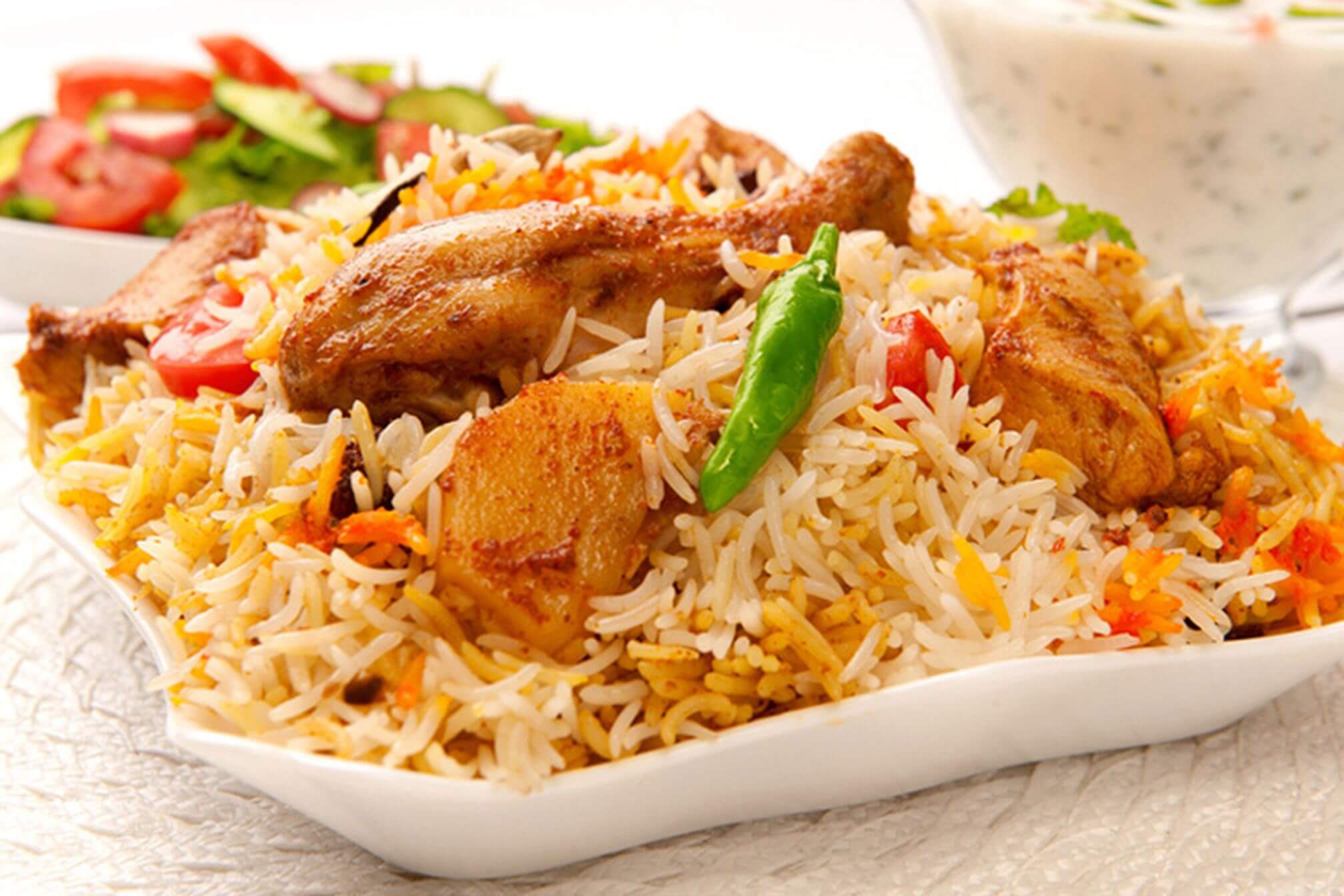
Saag: Saag is a traditional dish made with leafy greens, typically spinach or mustard greens, cooked with various spices and sometimes other vegetables. These greens are simmered to perfection, often with onions, tomatoes, garlic, and a blend of spices like cumin, coriander, and turmeric. The resulting dish is a nutritious and flavorful side that pairs well with flatbreads or rice.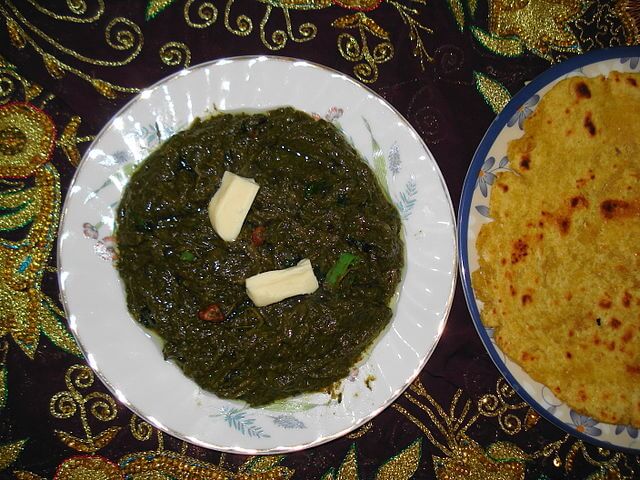
Kebabs: Kebabs in Larkana are typically skewers of minced meat, often lamb or beef, mixed with a variety of spices and herbs like coriander, cumin, and mint. The mixture is shaped onto skewers and grilled or cooked over an open flame, imparting a smoky flavor. These kebabs are served with naan or rice and accompanied by chutneys or yogurt-based sauces.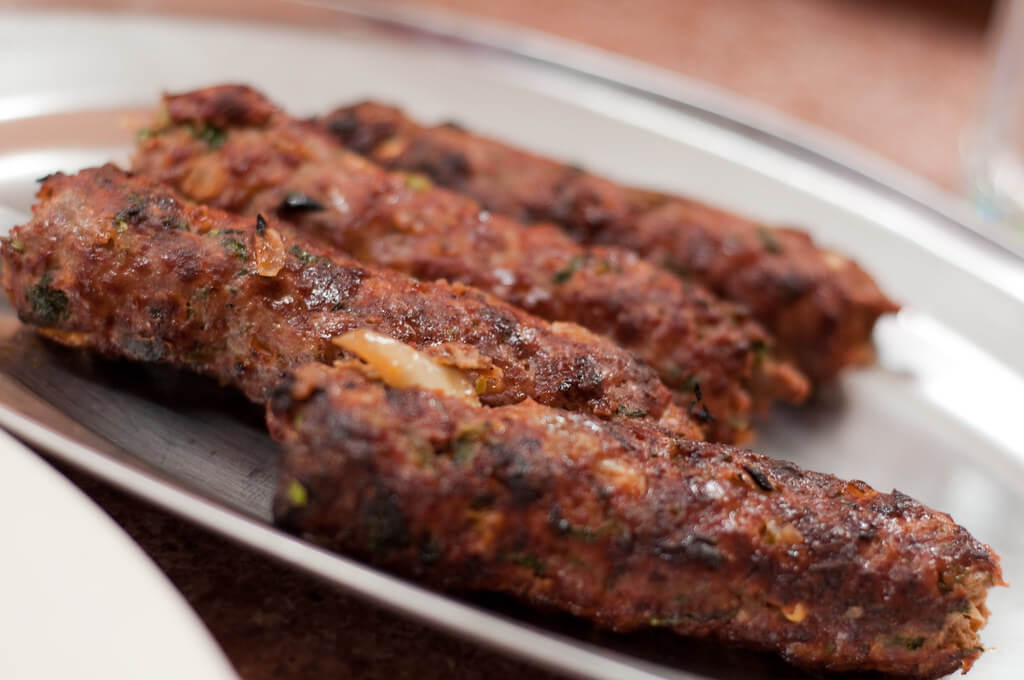
Dal Pakwan: Dal Pakwan is a classic Sindhi breakfast dish consisting of chana dal (split chickpeas) cooked with spices like cumin, turmeric, and garam masala. The dal is served with crispy, deep-fried flatbreads known as pakwan. These pakwans are thin, crunchy, and usually flavored with cumin seeds and black pepper, providing a delightful contrast to the creamy dal.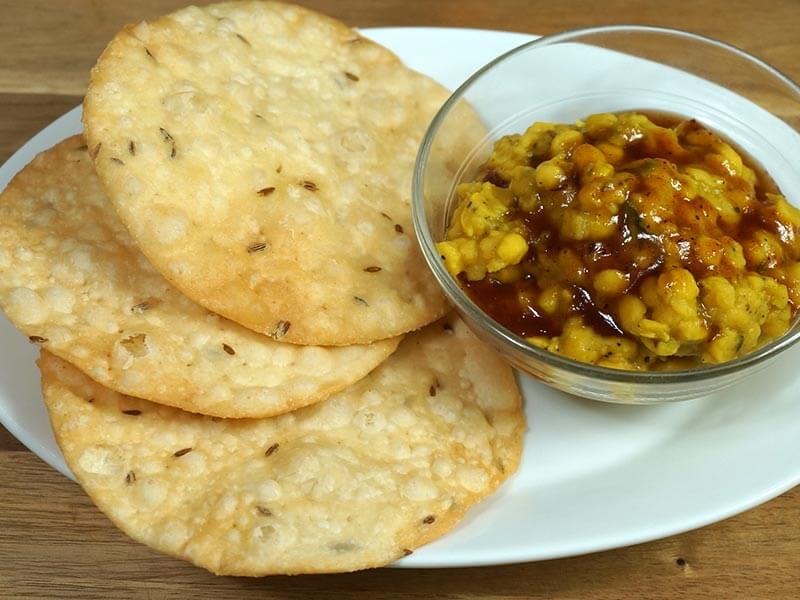
Sindhi Kadhi: Sindhi Kadhi is a tangy and spicy curry made from gram flour (besan), yogurt, and various vegetables like okra, potatoes, and drumsticks. It’s flavored with mustard seeds, curry leaves, fenugreek seeds, and other spices. This curry has a unique taste due to its sourness, imparted by tamarind or dried mango powder (amchur), and is usually served with steamed rice.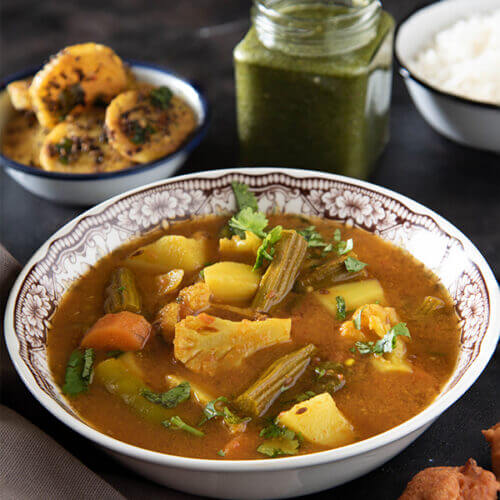
Koki: Koki is a type of unleavened flatbread made from whole wheat flour, onions, green chilies, and coriander leaves. The dough is rolled out into discs and then cooked on a griddle with ghee or oil until golden brown. It’s a popular breakfast item and is often served with yogurt or a spicy chutney.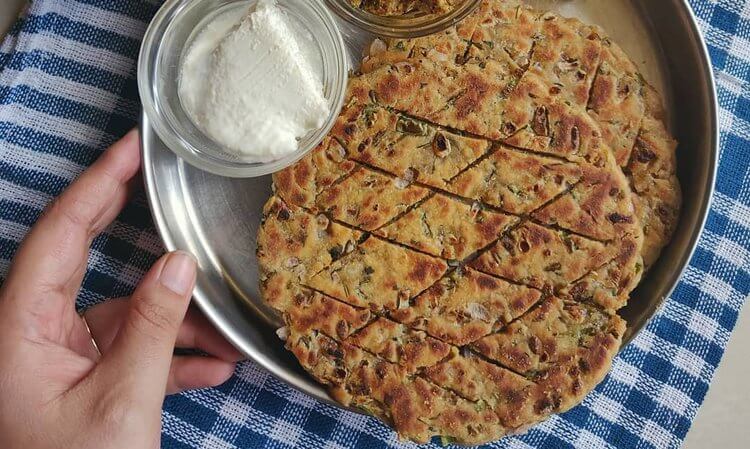
Seyal Mani: Seyal Mani is a traditional Sindhi dish made with minced meat (usually mutton) cooked in a rich gravy of tomatoes, onions, and spices like red chili powder, turmeric, and coriander. It’s slow-cooked to enhance the flavors and is often served with bread or rice.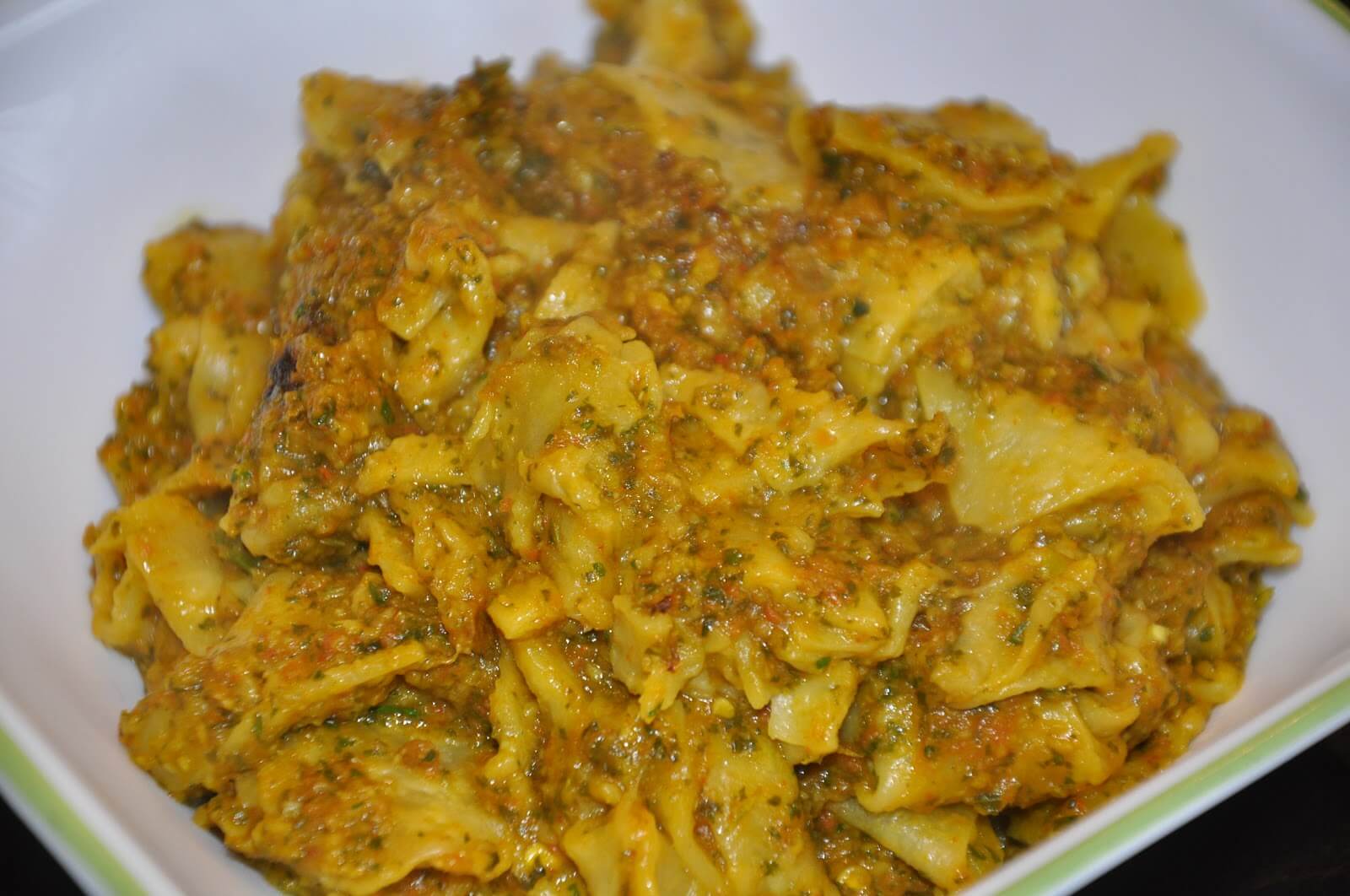
Sai Bhaji: Sai Bhaji is a nutritious Sindhi dish prepared with spinach, lentils, and mixed vegetables like carrots, potatoes, and tomatoes. The vegetables are cooked with spices like cumin, coriander, and garam masala until they form a thick, flavorful stew. This dish is commonly enjoyed with rice or roti.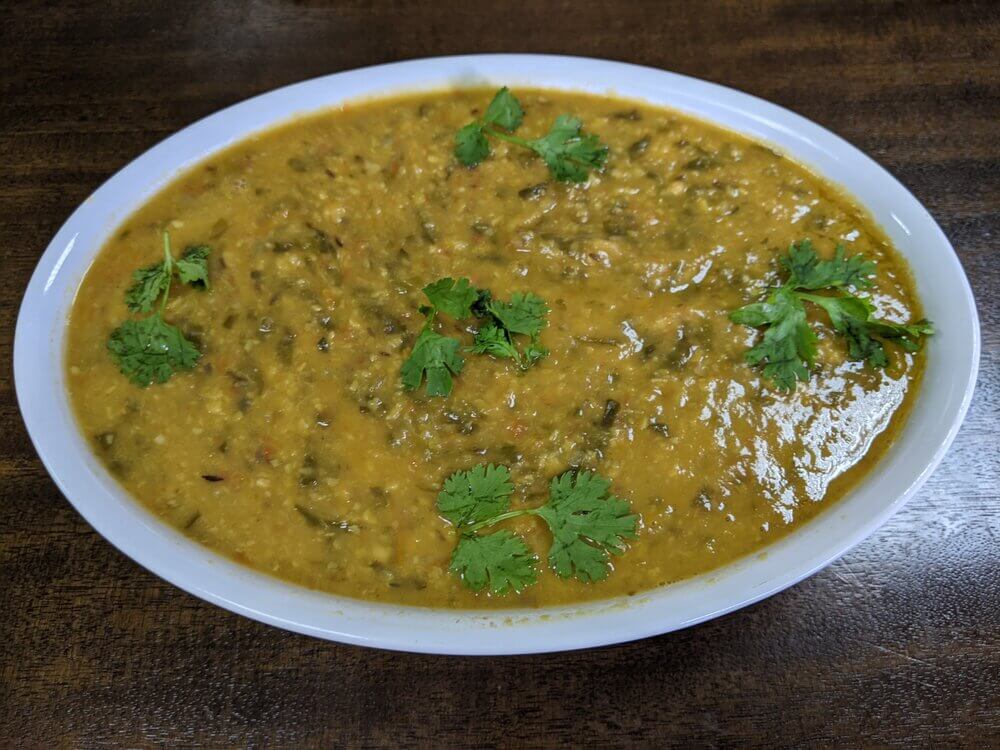
Dahi Baray: Dahi Baray consists of lentil-based dumplings soaked in spiced yogurt and topped with a variety of chutneys, including tamarind and mint, along with chaat masala for a burst of flavors. These savory bites are popular as snacks or appetizers in Larkana.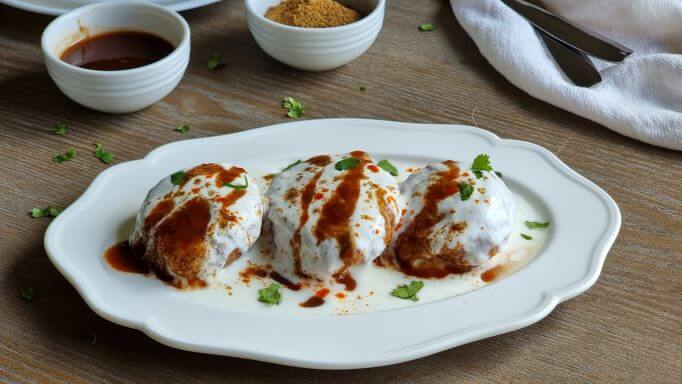
Sindhi Karhi: Sindhi Karhi is a tangy curry made with yogurt and gram flour (besan) as its base. It’s cooked with assorted vegetables like okra, potatoes, and drumsticks, along with spices like turmeric, red chili powder, and fenugreek seeds. The dish has a distinctive sour taste and is best paired with rice.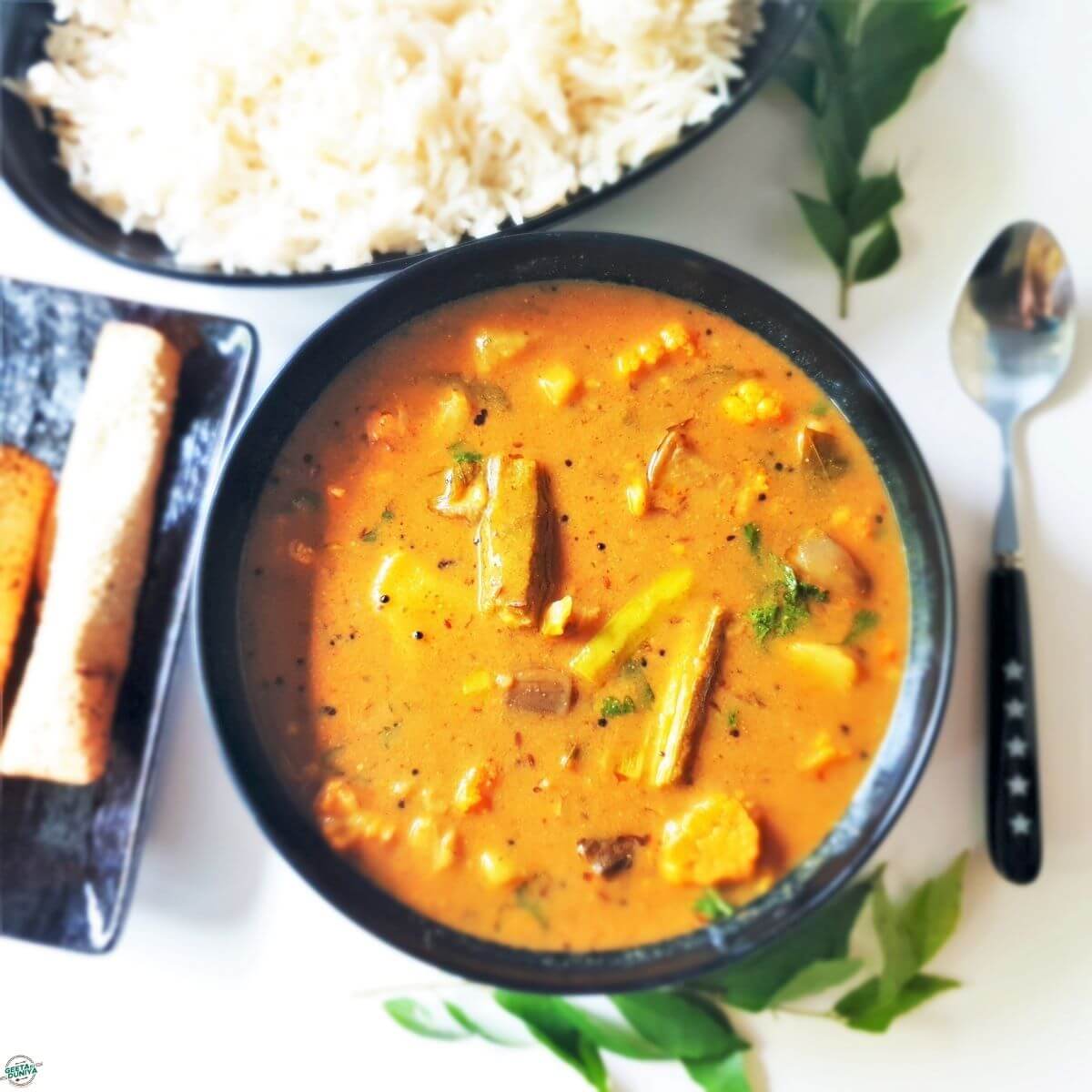
Bhugal Biryani: Bhugal Biryani is a variant of Sindhi Biryani, where the rice is cooked separately from the meat and then both are combined with aromatic spices, caramelized onions, and tomatoes. The meat is usually marinated with yogurt and spices before being layered with the rice, resulting in a flavorsome and fragrant dish.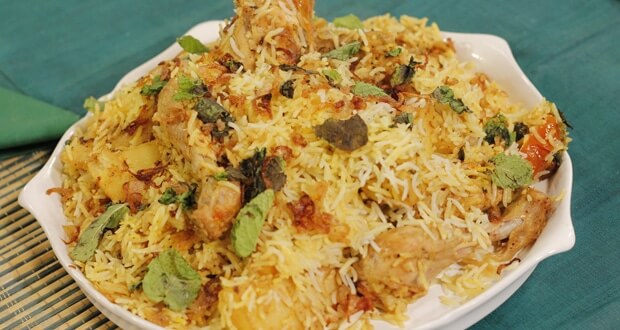
Mitho Lolo: Mitho Lolo is a sweet flatbread made from wheat flour, jaggery, and ghee. It’s cooked on a griddle until it turns golden brown and crispy. This dessert-like bread is enjoyed for breakfast or as a snack.
Thadal: Thadal is a refreshing drink made from a mixture of almonds, watermelon seeds, poppy seeds, cardamom, saffron, and milk. The ingredients are ground together to form a smooth paste, which is then diluted with water, chilled, and served as a cooling beverage, especially popular during hot weather.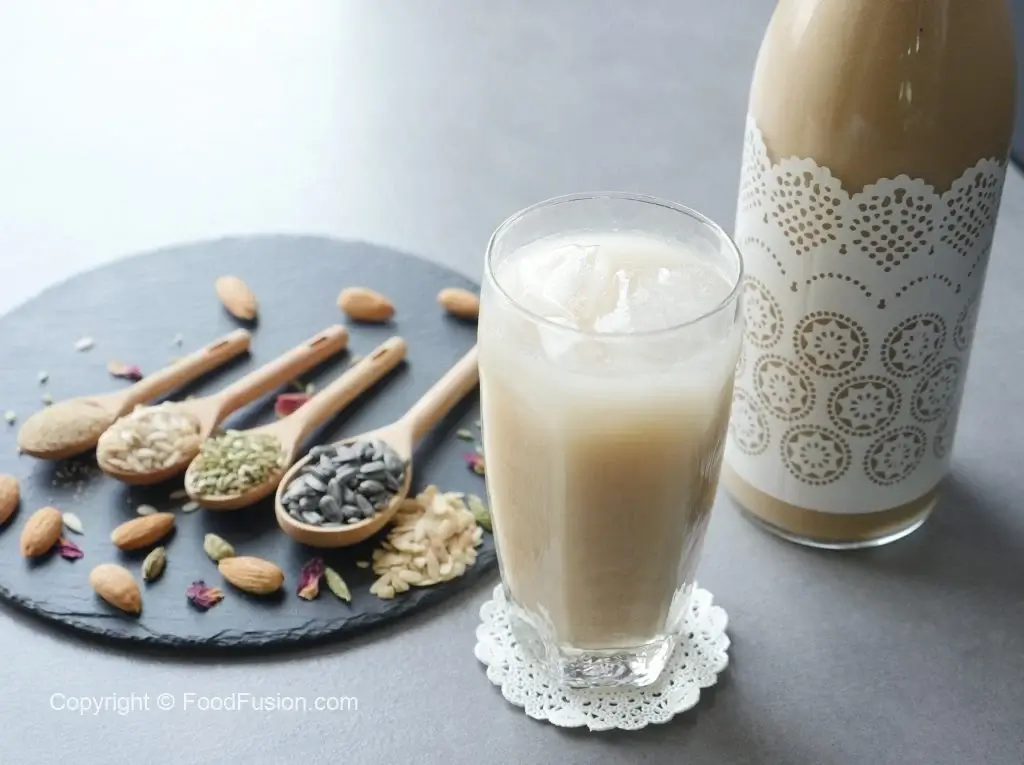
Kheema Fry: Kheema Fry is a spicy and flavorful dish made from minced meat, typically lamb or beef, sautéed with onions, tomatoes, and a blend of spices such as coriander, cumin, red chili powder, and garam masala. It’s cooked until the meat is tender and served as a side dish with rice or bread.
Sindhi Pulao: Sindhi Pulao is a fragrant rice dish cooked with a variety of spices, including cumin, cloves, cinnamon, and cardamom, along with caramelized onions, fried potatoes, and sometimes raisins and cashews. The rice is typically cooked with vegetables or meat, like chicken or mutton, resulting in a delightful and aromatic one-pot meal.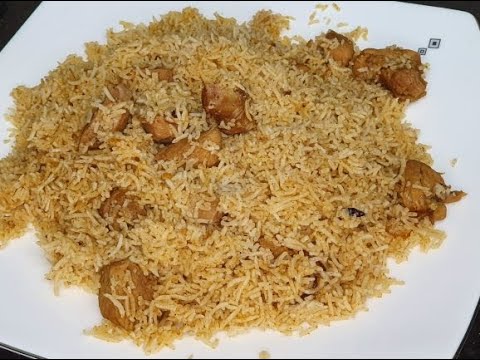
Pallo Machi: Pallo Machi is a renowned seafood dish in Larkana, particularly featuring a special type of fish called Pallo. The fish is marinated with a blend of spices including red chili powder, turmeric, coriander, and cumin, and then traditionally shallow-fried or grilled. It is often served with a side of rice or flatbread, offering a delightful taste of the region’s freshwater culinary expertise.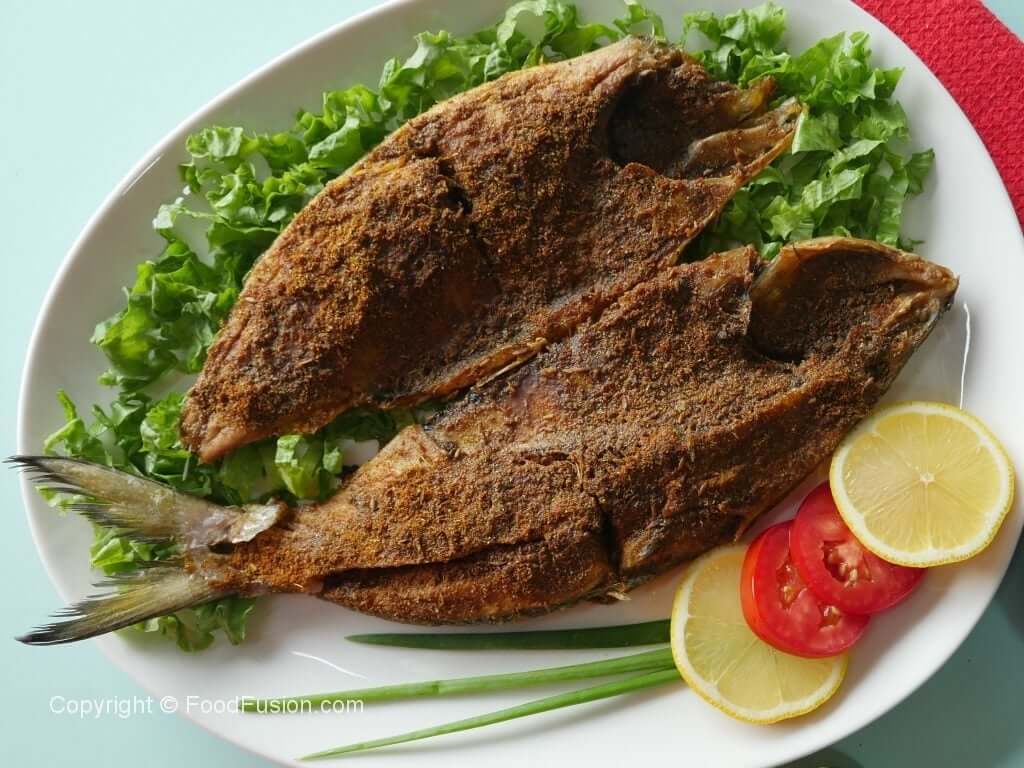
Kheer: Kheer is a beloved dessert in Larkana made from simmering rice, milk, sugar, and cardamom until it thickens to a creamy consistency. It’s often garnished with almonds, pistachios, or saffron strands, adding both flavor and a beautiful presentation. This sweet treat is frequently prepared during festivals and special occasions, offering a comforting and satisfying end to a meal.
Sohan Halwa: Sohan Halwa is a traditional sweet delicacy made from semolina, sugar, and ghee, and flavored with cardamom and saffron. The ingredients are cooked to a thick consistency, then cooled and cut into diamond-shaped pieces. This rich and aromatic dessert has a slightly chewy texture and is garnished with nuts, making it a popular choice for celebrations and festive gatherings.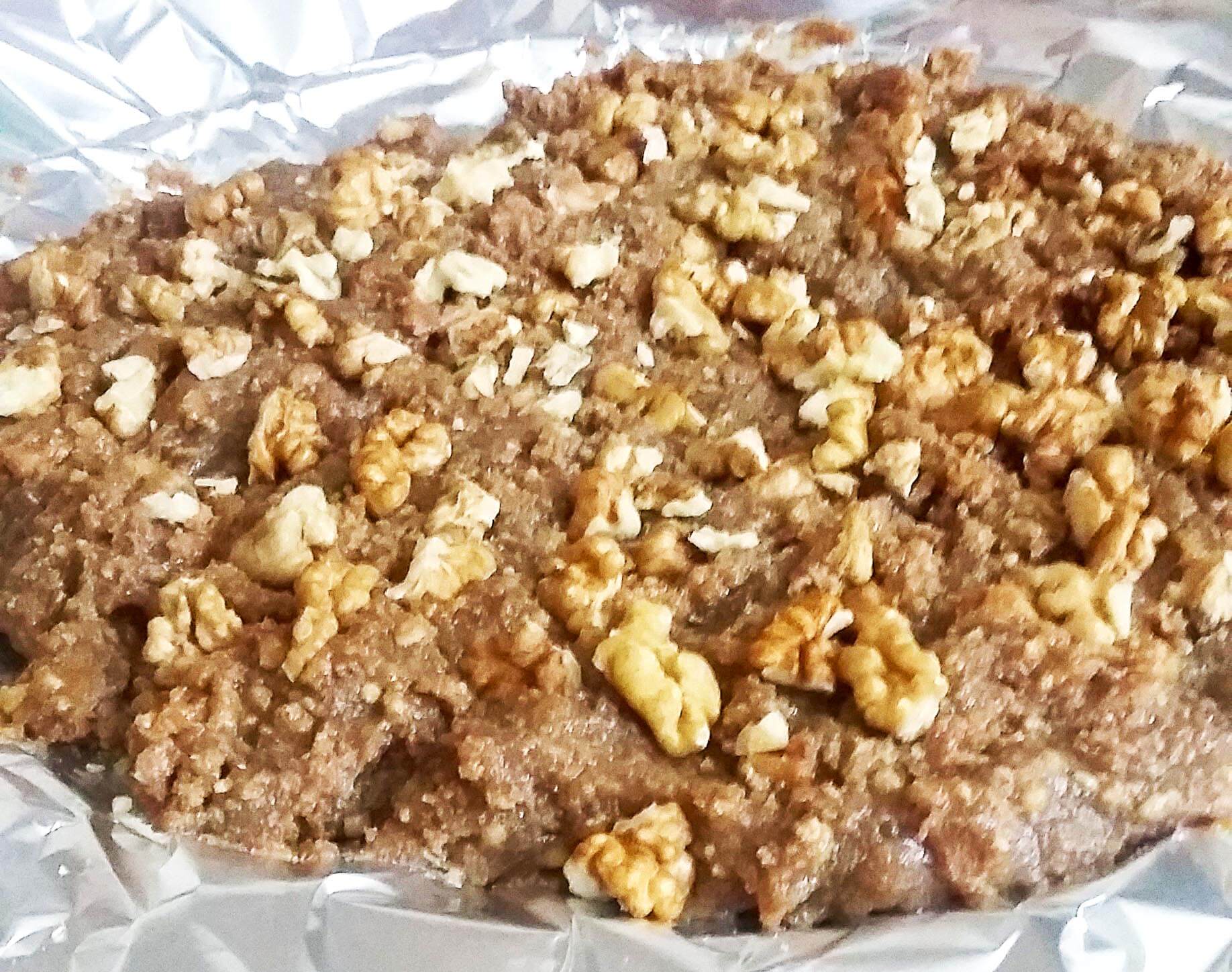
Chapli Kebab: Chapli Kebab is a meat patty originating from the Pashtun region, often found in Larkana’s culinary scene. It’s made with minced meat, typically beef or lamb, mixed with various spices like coriander, cumin, chili powder, and sometimes pomegranate seeds or tomatoes for extra flavor. The patties are flattened and shallow-fried, resulting in a crispy exterior and a juicy, flavorful interior. They’re usually served with naan bread or rice and accompanied by chutneys or yogurt.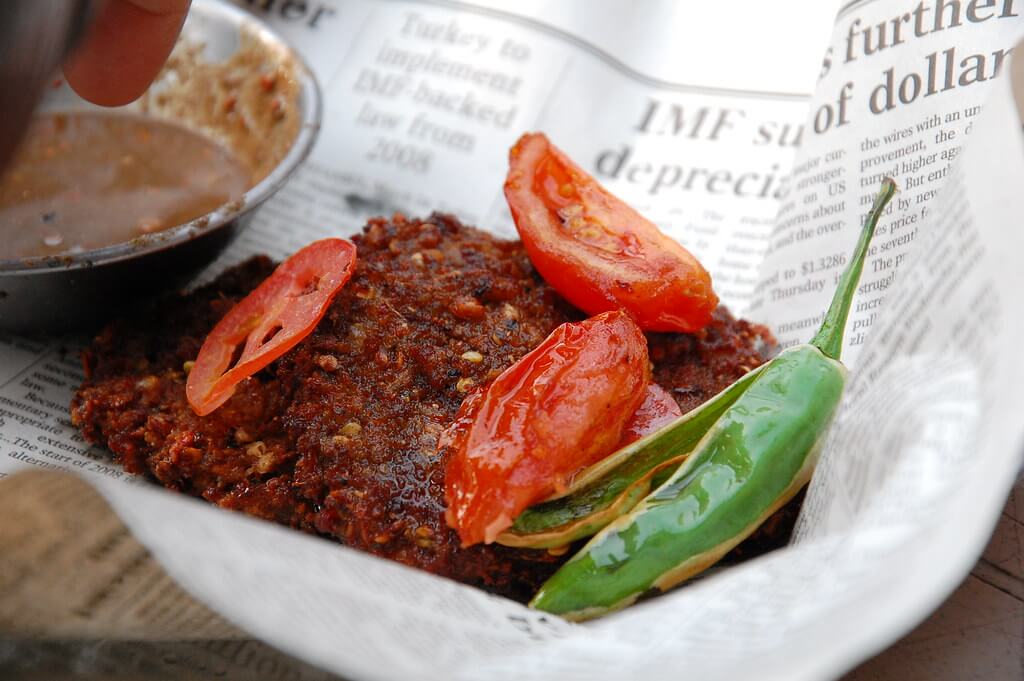
Lassi: Lassi is a refreshing yogurt-based drink enjoyed throughout Pakistan, including Larkana. It’s made by blending yogurt, water, and sometimes sugar or salt until frothy. Some variations include adding fruit or spices like cardamom for additional flavor. Lassi is a cooling beverage commonly served with meals or as a standalone drink, especially during hot weather.
Mutton Roast: Mutton Roast is a succulent meat dish made from marinated mutton pieces cooked with a blend of spices, including ginger, garlic, onions, tomatoes, and a mix of aromatic spices such as cumin, coriander, and garam masala. The meat is slow-cooked until tender and flavorful, resulting in a rich and hearty dish that pairs well with naan or rice.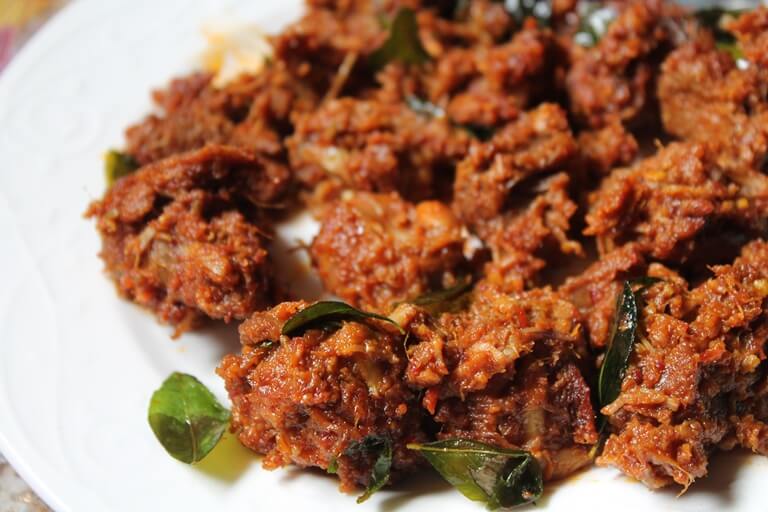
Fish Fry: Fish Fry is a popular dish in Larkana, involving marinating fish fillets with spices like red chili powder, turmeric, and cumin, then coating them in a seasoned batter before frying until crispy. The fish is usually served hot and accompanied by chutneys or sauces, providing a delightful crunch and burst of flavors.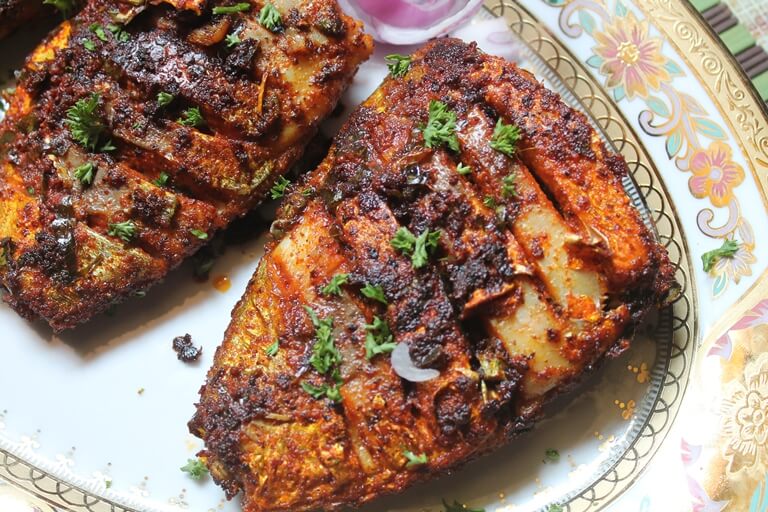
Bhajiya: Bhajiya refers to deep-fried fritters made from vegetables like potatoes, onions, spinach, or cauliflower dipped in a gram flour (besan) batter seasoned with spices like chili powder, turmeric, and cumin. These crispy snacks are enjoyed with chutneys or sauces, making them a popular street food option in Larkana.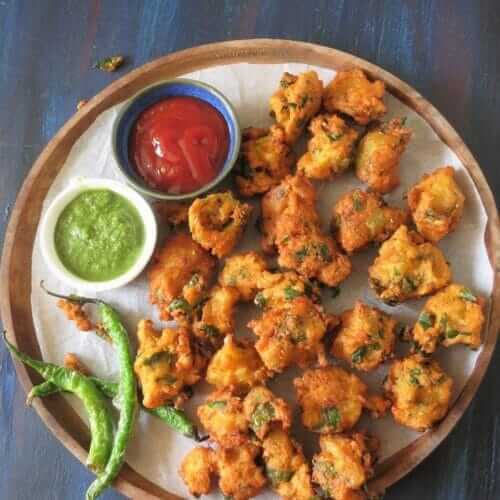
Sajji: Sajji is a flavorful and aromatic dish made by slow-roasting whole-marinated meat, often chicken or lamb, on a skewer or spit. The meat is typically seasoned with a blend of spices and herbs, including cumin, coriander, and garam masala, before being roasted over an open flame or in a tandoor. Sajji is known for its tender and juicy meat, usually served with naan or rice.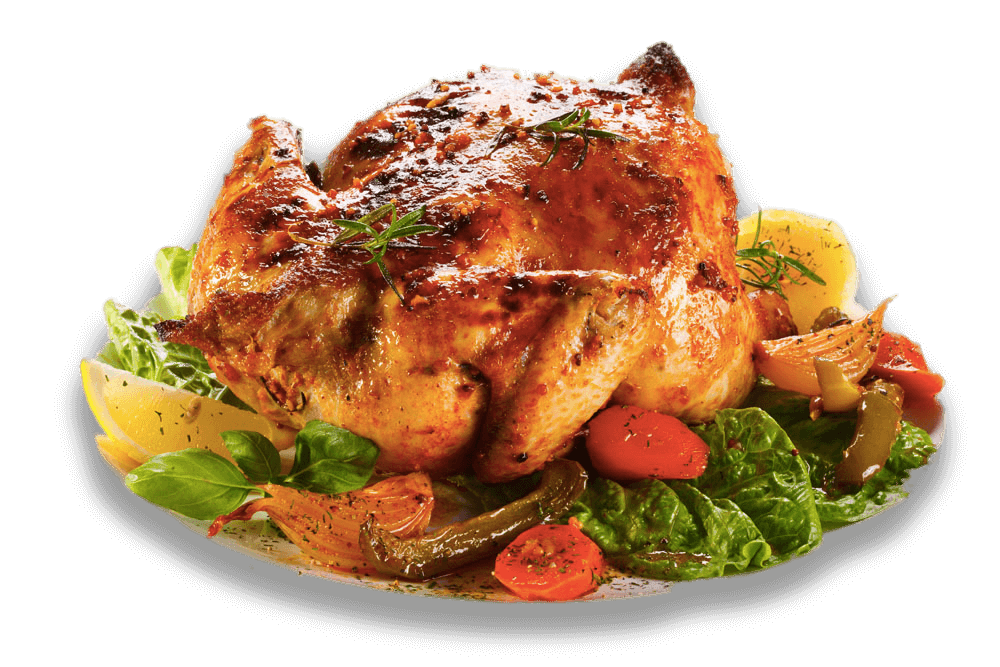
Falooda: Falooda is a chilled dessert beverage made with rose syrup, vermicelli noodles, basil seeds, and sometimes ice cream or milk. This sweet and refreshing drink has a unique texture and flavor profile, often garnished with nuts and served in tall glasses, making it a popular treat to beat the heat in Larkana.
Chicken Karhai: Chicken Karhai is a flavorful chicken dish cooked in a karhai (wok) with tomatoes, onions, ginger, garlic, and a blend of spices like cumin, coriander, and chili powder. The dish is known for its bold flavors and is typically garnished with fresh coriander before serving. It’s enjoyed with naan or rice, offering a satisfying and aromatic meal.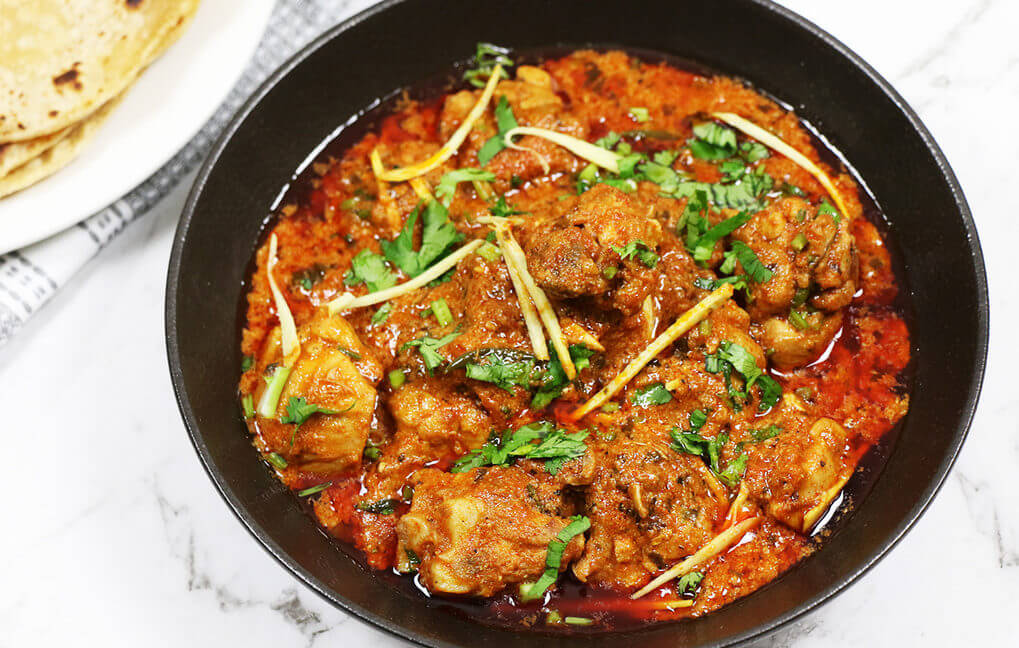
Patata: Patata refers to a simple yet delicious potato-based dish cooked with spices, onions, tomatoes, and sometimes green chilies. The potatoes are usually cubed and cooked until tender, absorbing the flavors of the spices and other ingredients. It’s a versatile and comforting dish often served as a side with bread or rice.
Sindhi Curry: Sindhi Curry is a tangy and spicy dish prepared with a base of gram flour (besan), yogurt, and a variety of vegetables such as okra, potatoes, and tomatoes. The curry is flavored with mustard seeds, curry leaves, and an assortment of spices, offering a delightful blend of flavors. It’s commonly served with steamed rice, providing a comforting and satisfying meal option.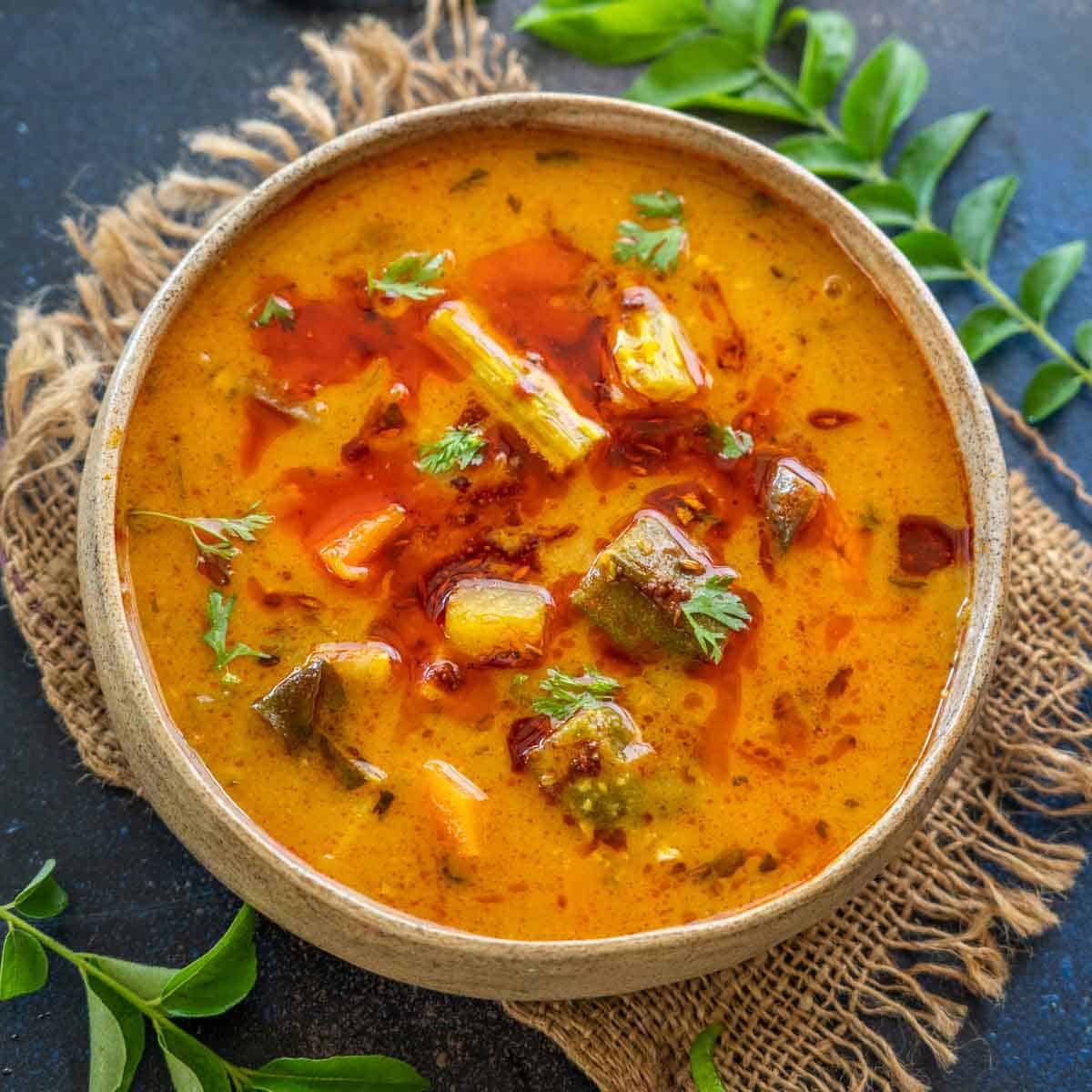
These dishes from Larkana represent a rich array of flavors and culinary traditions, showcasing the region’s diverse gastronomy. Each dish carries its unique blend of spices and ingredients, offering a delightful culinary experience for locals and visitors alike.
History and Culture
Culinary Roots and Influences
Overview of Historical Influences on Food in Larkana Larkana’s culinary heritage is deeply entwined with a rich tapestry of historical influences that have shaped its distinctive cuisine. One of the pivotal influences dates back to the ancient Indus Valley Civilization, a testament to the roots of the region’s gastronomy. The remnants of this ancient civilization provide glimpses into the food practices and dietary habits of the people who inhabited these lands millennia ago. The use of locally grown grains, spices, and an emphasis on a variety of vegetables and fruits can be traced back to these ancient times, establishing a foundation for “food in Larkana.”
Throughout the centuries, Larkana’s cuisine has been influenced by a myriad of dynasties and invaders who traversed these lands, leaving indelible marks on the local gastronomy. From the Arab conquests to the Mughal rule and later, the British colonization, each era introduced new ingredients, cooking techniques, and flavors to the regional cuisine. The amalgamation of diverse culinary traditions from these ruling powers and the assimilation of their culinary practices into the local fare have resulted in a diverse and dynamic food culture that resonates across Larkana.
Traditional Cooking Methods and Techniques
Unveiling Traditional Cooking Techniques The distinctiveness of “food in Larkana” is not solely derived from its ingredients but also from the traditional cooking methods and techniques passed down through generations. The use of clay ovens, locally known as tandoors, holds paramount significance in Larkana’s culinary traditions. These traditional ovens, fired by wood or charcoal, impart a unique smoky flavor and tenderness to various dishes like tandoori meats and bread, enhancing their appeal and distinctiveness.
Another noteworthy aspect of Larkana’s cooking methods is the emphasis on slow cooking. This approach involves patiently simmering ingredients over a low flame for extended periods, allowing flavors to meld and intensify, resulting in dishes with depth and richness. Additionally, unique preparation techniques like “dum” cooking, where dishes are sealed in pots with dough and slow-cooked, infuse flavors into the food, making it quintessentially representative of “food in Larkana.” These methods not only contribute to the nuanced flavors but also create textures that are cherished by locals and visitors alike.
Tips and Tricks
To truly savor the essence of food in Larkana, exploring its culinary landscape is a must. Whether you’re a local or a traveler seeking an authentic gastronomic experience, here are some invaluable tips and tricks to make the most of your culinary journey:
Dining Recommendations
When it comes to embracing the flavors of Larkana’s cuisine, several eateries stand out, offering an exquisite array of traditional dishes and specialties.
Must-Visit Culinary Hotspots For an immersive taste of Larkana’s culinary heritage, consider visiting Zaika-e-Sindh. This renowned restaurant encapsulates the essence of local flavors, serving up delectable dishes such as Sindhi Biryani, Sai Bhaji, and Pallo Machi. Another gem is Sindh Kitchen, celebrated for its Sindhi Pulao and tantalizing array of vegetarian delicacies like Seyal Mani and Sai Bhaji. For an authentic street food experience, explore the bustling food stalls near Resham Gali, offering a delightful variety of Bhajiya and Chapli Kebabs, prepared right before your eyes.
Highlighted Specialties at Recommended Spots At Zaika-e-Sindh, the Sindhi Biryani takes center stage, a fragrant rice dish infused with aromatic spices and succulent meat, embodying the essence of Sindhi cuisine. Meanwhile, Sindh Kitchen’s Sindhi Pulao presents a delightful symphony of flavors with its rice, meat, and signature spices, a must-try for those exploring traditional dishes. For a quick bite, the street vendors near Resham Gali serve crispy and flavorsome Chapli Kebabs and piping hot Bhajiya that are a hit among locals and visitors alike.
Cooking Tips and Authentic Recipes
To bring the vibrant flavors of Larkana’s cuisine into your kitchen, here are some tips and an authentic recipe to recreate the essence of food in Larkana at home:
Recreating Authentic Larkana Dishes To replicate the authentic taste of Larkana, focus on using locally sourced ingredients. Embrace the spice blend featuring cumin, coriander, turmeric, and red chili powder, essential in many dishes. Ensure to slow-cook meat for rich flavors or opt for traditional clay ovens or tandoors for that smoky essence. Balancing flavors is key – play with tanginess from tamarind or tomatoes, complemented by the sweetness of jaggery or sugar.
Ingredients
The essence of the food in Larkana lies in its distinct array of ingredients, each playing a pivotal role in shaping the rich flavors and textures of the regional cuisine.
Essential Ingredients
Key Components of Larkana’s Dishes The culinary repertoire of Larkana is characterized by a harmonious blend of spices, vegetables, meats, and grains that form the foundation of its delectable dishes.
- Spices: Cumin, coriander, turmeric, and red chili powder are the cornerstone spices in Larkana’s culinary palette. These spices not only lend vibrant hues but also impart depth and complexity to dishes like Sindhi Biryani, Sindhi Pulao, and Kheema Fry. The intricate balance of these spices is the hallmark of authentic food in Larkana.
- Vegetables: Okra, potatoes, tomatoes, and spinach are prominently featured in various Larkana dishes. Okra, known locally as “bhindi,” adds a unique texture to dishes like Sindhi Kadhi, while potatoes are a versatile ingredient, used in Sindhi Biryani and Aloo Tuk, among others.
- Meats: Mutton and chicken take center stage in Larkana’s meat-based delicacies. Mutton Roast, Sajji, and Chapli Kebabs showcase the expertise in preparing succulent and flavorful meat dishes that are intrinsic to the food in Larkana.
- Grains: Basmati rice, a staple in Larkana, forms the base for iconic dishes like Sindhi Biryani and Sindhi Pulao. The aromatic and slender grains are meticulously cooked to perfection, enhancing the overall dining experience.
Each of these ingredients not only contributes to the flavors but also reflects the historical and cultural influences that have shaped Larkana’s culinary heritage.
Local Produce and Specialties
Embracing Locally Sourced Ingredients Larkana prides itself on an abundance of locally sourced or indigenous ingredients that elevate the authenticity of its cuisine.
- Sindhri Mango: Renowned for its sweetness and aroma, the Sindhri mango is a prized local produce, often incorporated into desserts like mango lassi or used in chutneys to balance savory dishes.
- Shallots and Green Chilies: Locally grown shallots and fiery green chilies add distinct flavors and piquancy to numerous Larkana dishes, enhancing their taste profile and providing a touch of local authenticity.
- Specialty Grains: Local varieties of grains like “moti dana” (pearl millet) and “jowar” (sorghum) find their way into traditional bread and porridge preparations, offering a rustic appeal and nutritional richness to the cuisine.
- Larkana Markets: The vibrant markets, such as Resham Gali Market and Shahi Bazaar, are treasure troves for specialty ingredients. Here, one can find an assortment of fresh produce, aromatic spices, and local delicacies that form the heart and soul of food in Larkana. These markets pulsate with energy, offering a glimpse into the thriving culinary culture of the region.
Sustainability and Local Sourcing
The interplay between sustainability and local sourcing forms the bedrock of food in Larkana, fostering a symbiotic relationship between traditional flavors, community support, and eco-conscious practices.
Importance of Local Sourcing
Preserving Culinary Heritage The emphasis on sustainable and locally sourced ingredients not only ensures the freshness and authenticity of Larkana’s cuisine but also plays a pivotal role in preserving its rich culinary heritage. By sourcing ingredients locally, culinary artisans and home cooks alike maintain the integrity of traditional recipes, ensuring that time-honored flavors remain true to their origins. This concerted effort to preserve local produce, spices, and meats contributes significantly to the distinctive taste profile of food in Larkana, safeguarding its legacy for future generations.
Supporting Local Communities Beyond flavor preservation, local sourcing bolsters the economic backbone of Larkana’s communities. By procuring ingredients from nearby farms, markets, and small-scale producers, the culinary ecosystem not only supports local livelihoods but also fosters a sense of community solidarity. This interconnectedness between producers, vendors, and consumers forms the cornerstone of sustainable development, empowering local communities and fortifying the cultural fabric woven around food in Larkana.
Restaurants and Markets Promoting Sustainability
Champions of Eco-friendly Practices Several dining establishments and markets in Larkana exemplify a steadfast commitment to sustainability and responsible sourcing, setting an exemplary standard in the culinary landscape.
- Green Eats Café: This eco-conscious eatery champions sustainability by procuring organic ingredients from local farmers, minimizing carbon footprints, and advocating for eco-friendly packaging. Their menu not only celebrates the essence of food in Larkana but also resonates with environmentally conscious practices.
- EcoMarket at Resham Gali: This bustling market is a hub for sustainable produce, offering a diverse array of locally sourced fruits, vegetables, and spices. Vendors here prioritize organic farming practices, emphasizing the importance of reducing agricultural impact on the environment.
Pairings and Recommendations
Enhancing the gastronomic journey of food in Larkana involves not only relishing the delectable dishes but also exploring perfect pairings and diverse culinary experiences that elevate the overall dining experience.
Beverage Pairings
Complementing Larkana Dishes To complement the vibrant flavors of food in Larkana, consider pairing these dishes with suitable beverages that harmonize and accentuate their taste profiles. For spicy and aromatic dishes like Sindhi Biryani or Chapli Kebabs, a refreshing glass of lassi serves as an excellent counterpart. The coolness of lassi, a traditional yogurt-based drink, balances the spiciness and adds a creamy texture, enhancing the dining experience.
For those indulging in milder dishes such as Sindhi Pulao or Sai Bhaji, opt for light-bodied wines like Riesling or Pinot Noir. The subtle fruity undertones of these wines complement the nuanced flavors of the dishes without overpowering them.
Furthermore, traditional beverages like Thadal, a cooling drink made from almonds, fennel seeds, and milk, offer a soothing accompaniment to a variety of dishes, especially during warmer weather. These well-thought-out pairings enhance the flavors of food in Larkana while providing a delightful sensory experience.
Other Dishes and Culinary Experiences
Exploring Neighboring Specialties Beyond the realm of Larkana cuisine, neighboring regional specialties and fusion culinary experiences offer a captivating tapestry of flavors and culinary diversity.
For those looking to expand their palate, exploring nearby regions can unveil a treasure trove of gastronomic delights. Head towards nearby Sukkur or Hyderabad to savor the flavors of Sindhi Kadhi or Sohan Halwa, extending the culinary journey beyond Larkana while staying rooted in the essence of Sindhi cuisine.
Moreover, fusion cuisine options, such as Indo-Chinese or Desi-Continental blends, are gaining popularity in local eateries. These innovative concoctions infuse traditional recipes with global influences, offering a contemporary twist to food in Larkana. Indulging in these diverse culinary experiences provides a broader perspective on the culinary landscape while celebrating the fusion of flavors and cultures.
Cultural Significance
The profound cultural significance of food in Larkana transcends mere sustenance, weaving a tapestry of traditions, values, and communal celebrations that reflect the essence of the region’s heritage.
Food as a Cultural Marker
Role in Shaping Culture and Society In Larkana, food serves as more than just a means of nourishment; it acts as a cultural marker deeply embedded in the social fabric. The preparation and sharing of meals hold immense significance, symbolizing hospitality, unity, and familial ties. The culinary heritage of Larkana mirrors the cultural values and customs cherished by its inhabitants. The meticulous preparation of traditional dishes often passed down through generations, embodies the essence of familial bonds and cultural pride.
Moreover, food in Larkana reflects the region’s reverence for communal dining, where shared meals foster a sense of togetherness, bridging gaps and fostering camaraderie among individuals. The act of cooking and dining together symbolizes harmony, respect, and a celebration of diversity, transcending linguistic or societal barriers.
Festivals and Food Traditions
Culinary Extravaganzas and Rituals Festivals and cultural events in Larkana are intrinsically intertwined with food-related traditions that form an integral part of local celebrations. During festive occasions like Eid-ul-Adha, the sacrificial feast of qurbani meat is central to the celebrations, where families share the meat with relatives, neighbors, and the less fortunate, embodying the spirit of charity and unity.
Moreover, festivals like Sindhi Cultural Day are vibrant showcases of Larkana’s cultural heritage, where traditional dishes take center stage. These celebrations are marked by an array of delectable dishes, ranging from savory Sindhi Biryani to sweet delights like Sohan Halwa, serving as culinary ambassadors of the region’s cultural identity.
The art of preparing and sharing specific dishes during auspicious occasions, such as weddings or religious ceremonies, holds profound cultural significance. These food-related traditions not only signify auspicious beginnings but also reinforce familial ties and communal bonds, illustrating the profound influence of food in Larkana on social cohesion and cultural expressions.
Conclusion
In essence, the culinary landscape of Larkana, adorned with a vibrant tapestry of flavors, traditions, and cultural heritage, stands as a testament to the rich and diverse food culture inherent in the region. The amalgamation of indigenous ingredients, time-honored recipes passed down through generations, and the celebratory spirit surrounding food in Larkana paints a vivid picture of the city’s gastronomic richness.
From the tantalizing aromas wafting from street-side stalls to the intricate flavors meticulously crafted in local kitchens, every dish in Larkana embodies a story, a tradition, and a slice of the city’s history. It’s a journey through a myriad of spices, textures, and tastes that unravel the soul of a culture deeply rooted in its culinary traditions.
As you embark on your gastronomic exploration, we encourage you to delve into the diverse and unique culinary experiences that food in Larkana has to offer. Embrace the warmth of hospitality, relish the authenticity of local flavors, and immerse yourself in the cultural richness that each dish encapsulates. Let the scents and flavors guide you through this culinary odyssey, where every bite narrates a tale of heritage, unity, and the vibrant essence of Larkana’s food culture. Indulge, discover, and cherish the unparalleled gastronomic journey that awaits in this captivating city.

